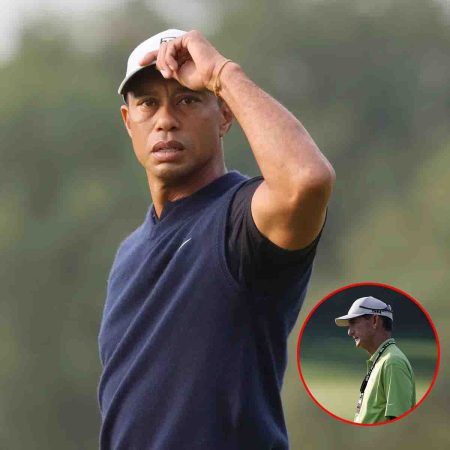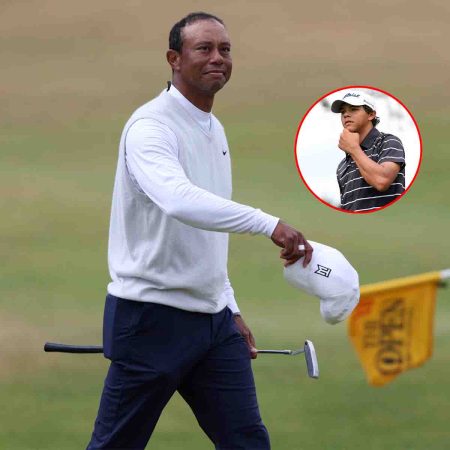/cdn.vox-cdn.com/uploads/chorus_image/image/72080250/usa_today_20239883.0.jpg)
Age isn’t stopping Steph anytime soon.
How many players in history under 6’3” can truly be considered unguardable? To qualify that term: How many of the NBA’s small men evoke that certain feeling of inevitability?
A few candidates come to mind. Allen Iverson had the huge heart to compensate for his lack in size. In the modern game, Damian Lillard certainly is capable of shooting the lights out and using the threat of his pull-up mastery to drive past tight defending and finish at the rim.
But perhaps no other small man in NBA history could evoke that feeling of inevitability as much as Steph Curry — who, at 35 years old, is evolving in ways that transcend age and the ticking clock that accompanies its increase.

Put yourself in defenders’ shoes — as Eric Apricot of Dub Nation HQ always puts it, no one ever gets fired for sticking to Steph Curry. You try your best to crowd his space, run him off the line, and pray he misses a mid-range jumper, hope that help behind you is ready to contest at the rim, or that Curry passes to a teammate preferably not named Klay Thompson.
But it’s easier said than done when Curry manages to create space in all sorts of ways. A hesitation there. A step-back here. Or a combination of both. If you’re especially unlucky, he hits you with a crossover too.
That’s what happened against Terance Mann and Paul George on these possessions:
Curry evokes a unique brand of inevitability. It’s not so much a sense of dread as it is a sense of frustration for opponents — here’s a guard who’s smaller than your typical alpha wing scorer in the mold of Michael Jordan and Kobe Bryant, and a full foot shorter than the behemoth all-time-great centers who have made the paint their dominion.
A guy this small shouldn’t be dominating — but yet, he is.
Add the fact that Curry isn’t exactly devoid of emotion. Whereas the likes of Michael and Kobe figuratively spit on the graves of their opponents, Curry dances upon it with glee and joyous mockery — not exactly the ice-in-his-veins kind of image that paints the picture of what an NBA alpha should be.
But every now and then, that facade of joy cracks — and out comes the alter ego more commonly known as ‘Psycho Steph’:
:no_upscale()/cdn.vox-cdn.com/uploads/chorus_asset/file/24512308/Psycho_Steph.jpg)
These outward displays of ‘Psycho Steph’ are few and far in between; Curry sometimes saves it for when games truly matter, such as his Game Four masterpiece against the Boston Celtics last season. But whenever it comes out, you know opponents have their work cut out for them.
The Los Angeles Clippers did whatever it took to slow Curry down, but nothing seemed to work. It took them going blow-for-blow with their own offensive success to get past the Golden State Warriors, who lost their ninth consecutive road game.
Results are hardly immaterial, but it’s not a crime to set it aside for a moment to admire Curry’s latest scoring binge. He dropped 50 points on 28 shots — 12-of-14 on twos, 8-of-14 on threes — and put up a highly efficient true shooting mark of 84.0%.
Seeing as how Curry dueled against Kawhi Leonard — himself putting up 30 points on 67.9 TS% — it’s appropriate to contrast how they operate. The great Nekias Duncan of Basketball News had this to say about Leonard:
What shouldn’t be lost in all the hoopla surrounding the Clippers — Russell Westbrook talk, rotation talk, podcast talk, Western Conference standings talk — is the metronomic, inevitable nature of Kawhi.
There isn’t a term other than ‘metronomic’ that perfectly describes the way in which Leonard picks apart opponents. He goes about his business with a no-nonsense approach, devoid of pure emotion and with a singular focus.
His goal is simple: get to his spots, patiently find the smallest of holes presented by his defender, and exploit them to inflict maximum damage.
On the contrary, Curry is anything but metronomic. He is a ball of pure energy and chaos. He thrives in the pockets of randomness that most NBA players find discomfort in.
When defenses oscillate between the spectrum of ballscreen coverages, Curry seemingly has an answer for all of them. Switching a big that is unaccustomed and uncomfortable with guarding out on the perimeter allows Curry to lick his chops, knowing that he completely dictates the matchup:
If defenses opt to meet him up higher at the level of the screen — or commit to a full two-man coverage onto him — he has the vision and passing to deliver the ball to release valves:
Sometimes, it doesn’t even matter that defenses are bringing their big higher up on screens. Curry takes advantage of the panic and slow feet by splitting the coverage and finding himself with an open lane to the rim, where he’s finishing at a career-high rate of 75.2%.
Let me reiterate: Curry is 35-years old, an age where only the best of the best have historically aged like fine wine. He can count himself among the likes of Jordan, LeBron James, and Kareem Abdul-Jabbar — to name a few — who still maintain a high level of play despite entering their mid-thirties.

The numbers wholeheartedly support the notion that Curry still has plenty left in the tank. He’s up to 30.1 points on 59.0% shooting on twos, 44.0% shooting on threes (on 11.5 attempts per game!), and 91.5% on free throws.
He’s putting up an astronomical 67.3 TS% — which is on track to become the second highest scoring-efficiency mark of his career, behind his 2017-18 season (67.5) and above his unanimous MVP campaign (66.9).
Throw whatever advanced stats you want into the pot — Dunks & Threes’ estimated plus-minus metric has him fifth (+6.8) in the entire league. Among point guards, only Lillard (+7.0) is posting a higher EPM mark.
If not for missing 26 games, Curry would certainly be in the First Team All-NBA discussion. It’s tough to place him much higher than the Second Team, and even that may be generous for someone who’s played only 44 out of a possible 70 games.
The MVP discussion is even more out of reach, considering the Warriors are sixth in the Western Conference and could tumble down the standings even further if their road woes continue. What’s more amazing: The Warriors are 22-22 in games where Curry has played.
That boils down to a roster-wide problem more so than just Curry’s efforts being in vain. It’s going to be hard to repeat with Andrew Wiggins’ absence and Gary Payton II’s return date still up in the air. It also doesn’t help one bit that Andre Iguodala suffered a fractured wrist that could very well spell the end of his illustrious career.
It’s going to be a tough road for the Warriors — which means they may need more of these performances from Curry while also doing a much better job defending on the road.
The window is still there. It’s not as wide open as it used to be, but it’s still spacious enough for the Warriors to slip through and claim another championship. Whether that happens this year or next season remains to be seen.
The person holding that window open has always been Curry, who — at 35-years old —remains the greatest show on Earth.








